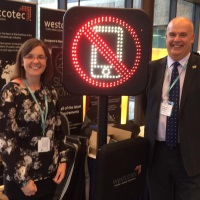Keele academic helps design new road safety device

A Keele University criminologist has contributed to the design of a new road safety device that detects the use of a mobile phone in a moving vehicle.
The device was developed by the traffic safety systems company Westcotec with the assistance of Keele’s Dr Helen Wells, a specialist in road policing.
The warning sign uses a sensor which is placed along the road which detects active 2G, 3G and 4G phone signals. When the sensor detects that a mobile is being used (other than for Bluetooth communication), it activates a sign showing an illuminated smart phone icon within a bright red circle and diagonal red line.
Dr Wells said: “The use of handheld devices has been illegal since 2003, and the recent increase in the penalty for this offence from three to six points and £100 to £200 represents an important step in educating drivers, but with declining numbers of traffic officers on our roads, we cannot rely on enforcement alone to change driver behaviour.
“The pace of technological development is fast outstripping the ability of the 15-year-old law to keep pace with the actual nature of the problem. The law refers to ‘driver’, ‘use’ of a ‘handheld’ ‘phone’ - four terms which are arguably a lot less clear now than when the law was originally drafted. Hands-free use has shown to be equally as dangerous as handheld use, yet is legal, so any driver assuming that the law was a good guide to safe behaviour would be encouraged to use an equally unsafe alternative. The Westcotec sign has a simple message about using a mobile in any sense of the word, and therefore reinforces a wider safety message than that being communicated by the law.”
Chris Spinks from Westcotec and former head of Norfolk and Suffolk Roads Policing Unit, said: “It was a chance meeting with Dr Wells at the National Roads Policing Conference in early 2017 that led to our mobile phone detector system being redesigned and improved to the point where it has now been released to the world. Thanks to her work around driver behaviour - particularly distraction - she was able to help us redesign the pictogram representation of the phone on the sign to ensure it was recognisable to all road users.
“She also gave us an insight into some of the psychology behind why drivers decide to do what they do. We are hopeful that we can continue to benefit from Dr Wells’ extensive experience and knowledge in her field as we develop other devices into the future.”
Whilst the warning device cannot differentiate between driver and passenger use of a mobile phone Mr Spinks says it’s “all part of the educational message”.
The first system is due to go live in Norfolk later this month, with several other UK police forces expressing an interest.

